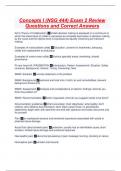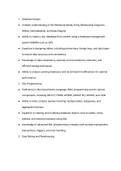Concepts I (NSG 444) Exam 2 Review
Questions and Correct Answers
Kim's Theory of Collaboration ✅Collab decision making is assessed on a continuum in
which the lowest level of collab is expressed as complete domination of decision making
by the nurse and the highest level is expressed as equally influencing joint decision
making
Examples of nurse-patient collab ✅Education, consent for treatments, advocacy,
collab from assessment to evaluation
Examples of nurse-nurse collab ✅Various specialty areas, mentoring, shared
governance
Pt care hand-off: IPASSBATON ✅Introduction, Patient, Assessment, Situation, Safety
concerns, Background, Actions, Timing, Ownership, Next
SBAR: Situation ✅concise statement of the problem
SBAR: Background ✅pertinent and brief info r/t sitch; dx and comorbidities; relevant
background clinical info
SBAR: Assessment ✅Analysis and considerations of options; findings; what do you
think the problem is?
SBAR: Recommendation ✅Action requested; what do you suggest needs to be done?
Documentation guidelines ✅Chart accurately; chart objectively; write legibly; don't
criticize; don't destroy documentation; don't leave vacant lines; no generalized
statements; begin each with date/time and end with signature and creds; document only
for yourself
Pain ✅an unpleasant sensory and emotional experience associated with actual or
potential tissue damage
Acute Pain (aka transient pain) ✅protective; usually has an identifiable cause; short
duration; limited tissue damage and emotional response
Neuropathic pain ✅abnormal processing of pain message; burning, shooting in nature
Nociceptive pain ✅somatic and visceral
, Chronic Pain ✅Enduring pain; does not decrease over time; may occur in muscles,
joints, and the lower back; may be caused by enlarged blood vessels or degenerating or
cancerous tissue; other significant factors are social and psychological
Physiological reactions to pain ✅Tachycardia, tachypnea, elevated BP, increased BG,
diaphoresis, pupil dilation, decreased gastric motility
How do you assess pain in non-verbal pt? ✅Facial expressions, body posture
Non-pharmacological pain relief ✅Ice/heat
Migraine headache ✅Blood vessels in brain overreact to triggering event, causing
spasms in arteries at base of brain; cerebral arteries dilate
How long do migraines last? ✅4-72 hours
Other aspects of migraines ✅Familial, women > men
Photophobia or phonophobia
Stages of Migraine ✅Prodromal, aura, Headache, Termination
Pharmacological treatment of migraines ✅NSAID, CCB, or antiepileptic
Treatment of mild migraines ✅acetaminophen
Treatment of severe migraines ✅Almotriptan, rizatriptan, midrin
Gout ✅Systemic disease in which uric acid deposits in joints and other body tissues,
causing inflammation; in one or more small joints (usually metatarsophalangeal joint of
the great toe)
Nutrition and Lifestyle Recommendations for Gout ✅Avoid fad starvation diets, no
alcohol, avoid stress, low purine diet, avoid sardines and shellfish, avoid aspirin and
diuretics, drink plenty of fluids, maintain healthy weight
Diagnostic testing for gout ✅ESR, uric acid levels, BUN, serum creat, arthocentesis
Acute pharm mgmt of gout ✅Combo of colchicine and NSAID
Chronic pharm mgmt of gout ✅Allopurinol, Febuxostat, or Probenecid






